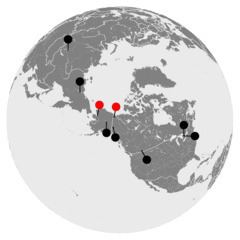Family Ochotonidae Rank Species | Phylum Chordata Genus Ochotona | |
 | ||
Similar Sardinian dhole, Acratocnus, Equus scotti, Megalotragus, Mylohyus | ||
Giant pika, Wharton's pika (Ochotona whartoni) is an extinct Pleistocene and early Holocene species of mammal in the family Ochotonidae, distributed in the northern parts of North America (Alaska, USA and Canada). Very similar forms were found also in Siberia.
Contents
Distribution
Giant pika was found in Alaska (United States), Yukon (O. whartoni and O cf. whartoni, large number of locations), Alberta and Ontario (Canada). Ochotona near O. whartoni (O. cf. whartoni) is known from Eastern Siberia and Kolyma as well.
Giant pika O. whartoni immigrated from Eurasia to North America during the Early Pleistocene via the Bering Land Bridge, along with small pikas close to the "O. pusilla group". Much earlier at the Miocene-Pliocene boundary came O. spanglei - the oldest Ochotona found in North America, what was followed by approximately three million year long gap in the known North American pikas record.
Detailed fossil distribution
(0.1 - 0.0 Ma / ~125,000-80,000 BP), at least 10 locations, O. cf. whartoni
(the species was discovered here)
Biology
Giant pika is much larger than other North American pikas, but of similar size to the extinct early and middle Pleistocene O. complicidens and extant O. koslowi (Koslov's pika), both from China, and may belong to one of them. Unlike American pika (O. princeps), giant pika habitat might be not scree slopes, but tundra and steppe, similarly to Euroasian pikas.
Occurrence and extinction
Giant pika was found in the North American fauna from Irvingtonian (1.8 - 0.3 Ma, Lower / Middle Pleistocene) throughout Middle Pleistocene to Late Pleistocene (0.1 - 0.0 Ma) locations.
But the last occurrence of the giant pika is known from early Holocene from eastern North America (a cave at Elba in the Niagara Escarpment, Ontario) and its radiometric date is 8670±220 years BP (14C age) or 10251-9140 BP (calibrated date). It is possible that the large form of Ochotona survived in the rocky areas along the Niagara Escarpment so long as a relict population.
